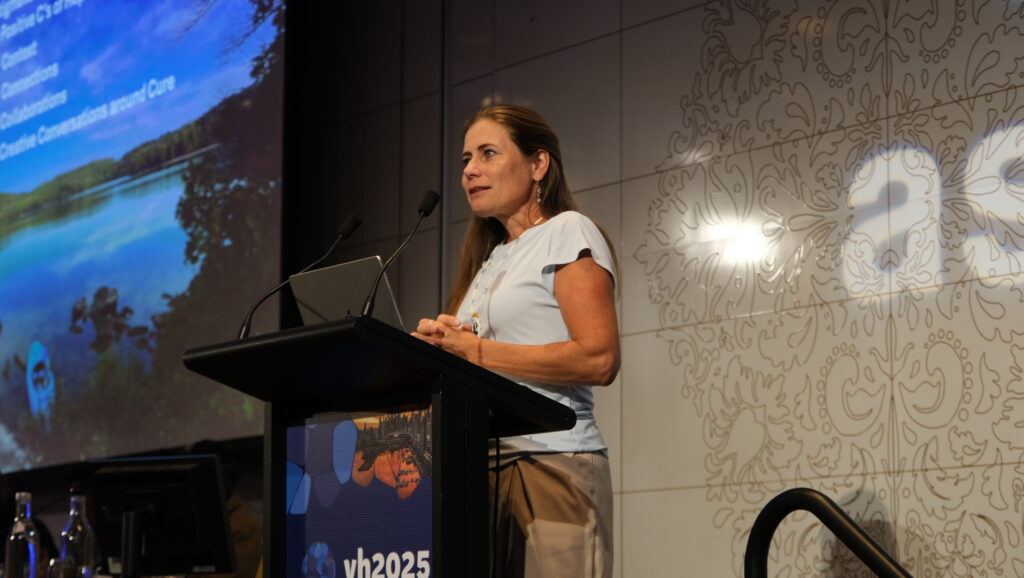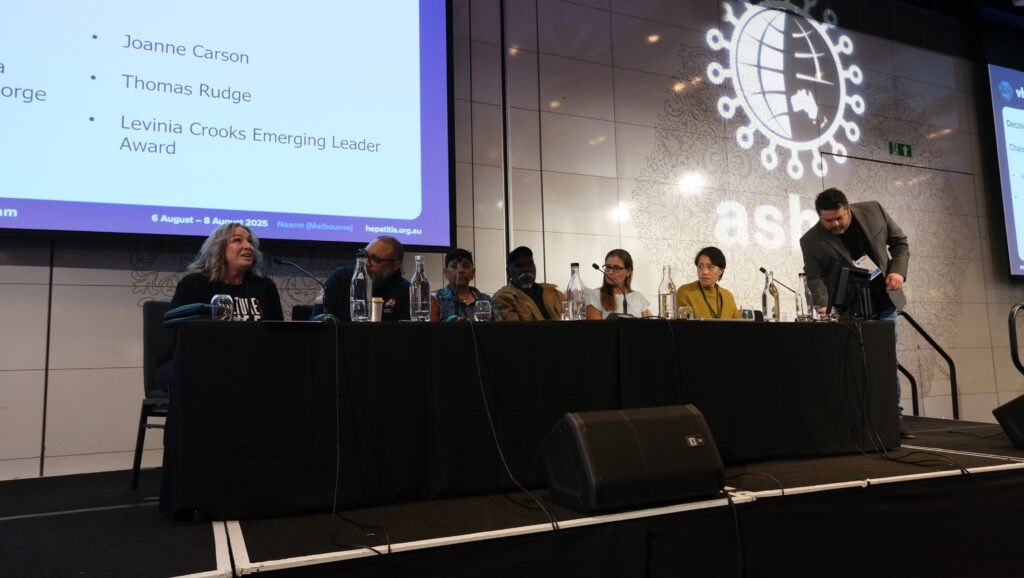This plenary session was proudly supported by Bellberry through their Participant Engagement Grant, enabling Aboriginal and Torres Strait Islander community voices to be centred at VH2025.

“Many sectors are not brave enough to centre these kinds of sessions,” said Troy Combo, chair of the ‘Decolonising and Destigmatising Viral Hepatitis’ panel session during the second day of the Australasian Viral Hepatitis Conference 2025 (VH2025).
“We’re talking about decolonising and destigmatising, but there’s another word to address: racism.”
Thanks to Bellberry’s support, ASHM was able to bring Aboriginal and Torres Strait Islander community members and health workers together to share their lived experiences and strategies for decolonising hepatitis responses.
During his opening address, Combo highlighted the ongoing impact of colonialisation on health disparities between Aboriginal and Torres Strait Islander peoples and non-Aboriginal people regarding viral hepatitis. Since 2015, there has been a steady decline in viral hepatitis rates among non-Aboriginal people, which hasn’t been the case for Aboriginal and Torres Strait Islander communities.
“Decolonising viral hepatitis involves transforming the way we understand, prevent and respond to hepatitis in Aboriginal and Torres Strait Islander communities,” said Combo.
“It must centre our voices, while acknowledging racism and structural inequities.”

Context, conversations and Indigenous perspectives
In a presentation prior to the panel discussion, Dr Kate Dunn – a member of the Mississaugi First Nation in what is now Ontario, Canada and Assistant Professor at York University – reflected on the history of colonisation, and how these legacies continue to manifest in healthcare today.
“When colonisation recedes, those nations don’t go back to the way they were,” said Dr Dunn.
“You can’t decolonise without putting something else in its place. We need to re-indigenise.”
Dr Dunn reflected on the history of colonisation in Canada, with particular focus on healthcare. She shared stories of ‘Indian hospitals’, and of the abuse that happened in them.
“It was a crime for Indigenous people to refuse medical treatment, or to leave these hospitals,” she shared.
“That led into subconsciously many people being raised to ‘don’t talk, don’t trust, don’t feel’. But in a healthcare setting you’re supposed to trust, you’re supposed to tell them what’s happening and feel like you’re in a safe space.”
Dr Dunn pointed to statistics around Indigenous populations having the highest burden of disease, but stressed the importance of considering the context – particularly that of colonisation – of how we got here in the first place.

Real stories, real solutions: Panel reflections
Following the presentation, Combo led a panel discussion with panellists Dr Dunn, Alvin Edney, Tina Goodwin, Nicky Guivarra and George Gurruwiwi. The panellists were asked to reflect on their work, and how we can better decolonise and destigmatise viral hepatitis care.
Tina Goodwin, Statewide AoD Coordinator at Tasmanian Aboriginal Centre, shared a story of a client from who had ended up in prison after being taken from his family as a child.
“He tried to go through corrections to go back to country, because that’s where he needed to be,” she said.
“But the parole board sat and said no – that has never happened and never will.”
“So, he came to us asking for help, because his cultural needs had not been met.”
Through hard work, Goodwin was eventually able to support this client to get back to his country.
“We can do better treatment with our fellas on land. We need to get them out of that system, get them healthy and get them back on our country where they need to be,” she said.
Alvin Edney, Registered Nurse with Derbarl Yerrigan Health Service, reflected on his work implementing needle and syringe programs (NSPs) and said that solutions “need to come from the community”.
“To address stigma, my approach is taking people on the journey. Share what the impact is, make it visible for people that we don’t see.”
“When people are accessing an NSP, they’re trying to make a choice. Do I use a ‘freshy’ or do I share needles? What is the impact of that choice on them, their families, their community?”
“But then when people are making hard choices – whether to spend money on food or housing or medicine – they know they can always go to the health service and get needle and syringe packs,” he said.
Through this work, Edney says Derbarl Yerrigan has been able to reduce rates of hepatitis while showing that the harm reduction approach of NSPs can work, while addressing some of the stigma around the use of injected drugs.
Nicky Guivarra, Aboriginal and Torres Strait Islander Lead at Hepatitis Queensland, shared how she uses her lived experience as a person who had hepatitis C to connect with the community and better understand what they need.
“A lot of my work is based around that lived experience,” she said.
“I’m yarning with people to get them to the clinic and to get tested. It’s all about communication, about language.”
Guivarra emphasised the importance of meeting people where they are, and understanding that different people will have different priorities.
“It’s about knowing where that person is in their life, and working with them from there. Being tested isn’t the first thing they’re worried about, it might be facing homelessness or jail,” she said.
George Gurruwiwi, Community Based Researcher at Menzies School of Health Research, highlighted the importance of established relationships in community and building trust with people.
“Engage people to come to the clinic, chat with them about this viral hepatitis,” he said.
“[Talk about] how liver [health] effects your community, show them what they can do.”
Real action: what do we do next?
The panel was a rich discussion on engaging Indigenous communities, and decolonising and destigmatising viral hepatitis care. But how do we put this into practice?
“Look at strength-based approaches with the person at the centre of the care, with a holistic approach including viral hepatitis,” said Edney.
“How do we frame language? How do we see the individual? Aboriginal young people are doing their best – it doesn’t help when the language we use is always framing them in a deficit. It’s time for us to lift them up.”
His sentiment was shared across the panel, with panellists agreeing it was about how services can meaningfully engage the community and ensure the agency of Aboriginal and Torres Strait Islander individuals in how they access health services.
This plenary session, made possible through Bellberry’s Participant Engagement Grant, amplified Indigenous voices and ensured their perspectives are heard beyond the conference. We are grateful to Bellberry for recognising the importance of community-led contributions to scientific meetings.

